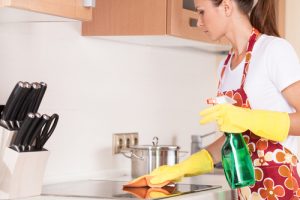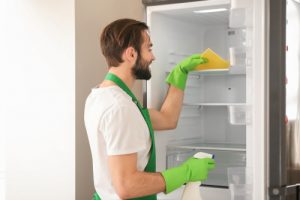
The kitchen is generally one of the germiest places in your average household. That’s why any reputable home cleaning in Thornton will recommend disinfecting and sanitizing it regularly. Nowadays, this takes on even greater importance due to the coronavirus pandemic. The virus can spread effortlessly from your kitchen and put your health at risk.
If you wish to ensure that your home remains a safe, germ-free environment, find out how you can properly sanitize the kitchen from COVID-19. Coming up are all the preventive measures you should take.
How to sanitize your kitchen during COVID-19?
Here’s what a kitchen sanitization process should look like:
Put on protective gloves
Wearing disposable gloves throughout the entire sanitization process is an effective measure to minimize the risk of coronavirus particles coming into contact with your skin. Gloves act as a barrier between your hands and potentially contaminated surfaces, providing an additional layer of protection.
When you begin the sanitization process, ensure that you put on a pair of disposable gloves. This applies to tasks such as cleaning high-touch surfaces, handling cleaning products, or coming into contact with potentially contaminated objects.
Remember to handle the gloves properly, ensuring they fit snugly and cover your hands completely. Avoid touching your face, eyes, or any other part of your body while wearing the gloves, as this can negate their effectiveness.
Once you have completed the sanitization process, carefully remove the gloves without touching the outer surface, and dispose of them appropriately. It is crucial to follow proper glove removal techniques to prevent any potential cross-contamination.
Additionally, remember that wearing gloves does not replace the need for regular hand hygiene. Even while wearing gloves, it’s important to practice proper handwashing techniques or use hand sanitizer when necessary. This further reduces the risk of potential transmission and ensures thorough cleanliness.
By consistently wearing disposable gloves during the sanitization process, you take an extra step in protecting yourself from potential exposure to coronavirus particles. This simple precaution contributes to maintaining a safer and healthier environment for yourself and those around you.
Clean the kitchen
Before you use your disinfectant, you need to clean the kitchen thoroughly. That’s because any dirt and debris on the surfaces you want to disinfect make it almost impossible for the disinfectant to reach the germs.
As usual, clean with warm water and soap or detergent. Unless there are stubborn stains on the surfaces, you don’t need to soak them for very long. After applying the cleaning mixture, rinse with warm water, and dry with paper towels or a cloth.
Unfortunately, the work is not over once you clean the kitchen. Since cleaning and disinfecting don’t produce the same results, a large number of germs will still remain. For this reason, cleaning is not enough.
To clean your kitchen surfaces, start by using warm water and soap or a suitable detergent. This combination is generally effective in removing common dirt and grease. Unless there are stubborn stains or substances, there is no need to let the cleaning mixture sit for an extended period. After applying the cleaning solution, rinse the surfaces with warm water, and then dry them thoroughly using paper towels or a clean cloth.
However, it’s important to note that cleaning alone is not sufficient to eliminate a large number of germs. While it removes visible dirt and grime, it may not effectively eliminate bacteria, viruses, or other pathogens. This is where disinfection comes into play.
After cleaning the kitchen, it’s necessary to follow up with a disinfectant. Choose an appropriate disinfectant product that is effective against the specific pathogens you want to target. Follow the instructions on the product label to ensure proper usage and contact time.
Apply the disinfectant to the cleaned surfaces, making sure to cover all areas thoroughly. Allow the disinfectant to sit for the recommended duration, as specified on the product label. This allows the disinfectant to effectively kill the remaining germs and reduce the risk of contamination.
Remember, cleaning and disinfecting are complementary processes. While cleaning removes dirt, disinfection targets harmful pathogens. By combining these two practices, you create a more hygienic environment and help reduce the spread of germs and infectious diseases.
Disinfect
This brings us to the core procedure – disinfection. In general, there are three disinfectants that are most commonly employed in the kitchen: alcohol, bleach, and hydrogen peroxide. Here’s how you can disinfect each one:
Alcohol: The most effective solutions contain 70% alcohol. Mixtures with higher concentrations evaporate too quickly, whereas those with lower concentrations are simply not powerful enough. To apply alcohol, put it in a plastic or glass spray bottle and spray it on a surface. Given that it evaporates rapidly, there’s no need to wash or wipe down the surface.
When it comes to using alcohol as a disinfectant, the most effective solution is one that contains 70% alcohol. This concentration strikes the right balance, as mixtures with higher alcohol concentrations tend to evaporate too quickly, while lower concentrations may not be potent enough to effectively kill germs. To utilize alcohol as a disinfectant, it’s recommended to pour it into a plastic or glass spray bottle. This allows for easy application and distribution on the desired surface. The advantage of using alcohol as a disinfectant is that it evaporates rapidly, which eliminates the need for additional washing or wiping down of the surface.
To apply the alcohol, simply spray it onto the surface, ensuring complete coverage. The rapid evaporation of alcohol helps minimize the contact time required to effectively kill germs. However, it’s important to note that certain surfaces may require longer contact time for optimal disinfection. Always refer to the instructions on the product label or consult with the manufacturer for specific guidance. While alcohol is effective against many types of germs, it’s important to remember that it may not be suitable for all surfaces. Some materials, such as certain plastics or sensitive electronics, may be damaged by alcohol. It’s advisable to check the manufacturer’s recommendations or conduct a spot test in an inconspicuous area before using alcohol on a new surface.
By using a 70% alcohol solution and following proper application techniques, you can effectively disinfect surfaces without the need for additional washing or wiping. This makes alcohol a convenient option for quick disinfection in various settings. Remember to always handle and store alcohol-based solutions safely, following any applicable safety guidelines.
Bleach: Mix 5 tablespoons of bleach with 1 gallon of water. Pour some of it into a spray bottle, apply it to an area, and let it air dry. If you’re spraying it on stainless steel, rinse the surface and wipe it down to prevent corrosion. While you’re disinfecting, make sure that the kitchen is properly ventilated since the fumes are toxic if inhaled.
When it comes to disinfecting with bleach, you can create a solution by mixing 5 tablespoons of bleach with 1 gallon of water. This solution can be effective in killing germs and pathogens on various surfaces.
To apply the bleach solution, pour some of it into a spray bottle for easy and controlled application. Spray the solution onto the surface you wish to disinfect, ensuring thorough coverage. Allow the solution to air dry naturally, as this provides sufficient contact time for the bleach to effectively kill germs.
However, it’s important to note that when using bleach on stainless steel surfaces, it is necessary to take additional steps. After applying the bleach solution, rinse the surface with water to remove any residue, and then wipe it down with a clean cloth. This helps prevent potential corrosion or damage to the stainless steel.
While using bleach as a disinfectant, it’s crucial to ensure proper ventilation in the area. The fumes released by bleach can be toxic if inhaled in high concentrations. Open windows or use exhaust fans to increase airflow and reduce the concentration of fumes in the space. It’s advisable to wear gloves and consider wearing a mask to protect yourself from any potential exposure to the fumes.
As with any cleaning or disinfecting product, it’s essential to handle bleach safely. Store it in a secure place, out of reach of children or pets, and follow the manufacturer’s instructions and safety guidelines.
By following these recommendations, including proper ventilation and precautions, you can effectively disinfect surfaces using a bleach solution while minimizing any potential risks associated with its use.
Hydrogen peroxide: Pour or spray hydrogen peroxide on a surface and let it rest for at least a minute before drying it. If you’re using a 3% solution, be extra careful with materials such as granite or marble because hydrogen peroxide can damage the finish. Additionally, be sure to spot-test the disinfectant on a small area of a colored surface since it can lead to discoloration.
Hydrogen peroxide can be used as an effective disinfectant by pouring or spraying it onto a surface and allowing it to rest for at least one minute before drying. This provides sufficient contact time for the hydrogen peroxide to kill germs and bacteria effectively.
However, it’s important to be cautious when using hydrogen peroxide, particularly on certain materials. If you are using a 3% solution, be extra careful when applying it to surfaces like granite or marble, as hydrogen peroxide can potentially damage the finish. It’s advisable to check with the manufacturer or conduct a spot test on an inconspicuous area before using hydrogen peroxide on such surfaces.
Additionally, when using hydrogen peroxide on colored surfaces, it’s essential to perform a spot test. Apply a small amount of the disinfectant on a discreet area to ensure it does not cause any discoloration or damage. This precautionary step helps prevent any unwanted effects on the color or appearance of the surface.
After the appropriate contact time has passed, ensure the surface is completely dry. You can use a clean cloth or allow it to air dry naturally. It’s important to note that hydrogen peroxide can have a bleaching effect, so it’s crucial to use caution when applying it to materials that are sensitive to discoloration.
Always follow the instructions provided on the hydrogen peroxide product label, including any safety precautions or recommended dilution ratios. Proper handling, storage, and ventilation are essential when using hydrogen peroxide as a disinfectant.
By being mindful of the potential effects of hydrogen peroxide on specific materials and conducting spot tests, you can effectively disinfect surfaces while minimizing the risk of damage or discoloration.
Once you’re done disinfecting, don’t forget to dispose of your gloves and wash your hands.
Where can I find the top home cleaning in Thornton? Just book Blue Spruce Maids!

Your house just can’t do without some top-to-bottom cleaning every now and then. But wouldn’t you rather skip housework and do something that doesn’t drain your energy? That’s why Blue Spruce Maids are here for you. Just give us a call, and our trustworthy cleaners will be on their way to take the cleaning out of your hands.
All our maids are seasoned experts who leave nothing to chance. They go through a stringent vetting process and provide services according to the highest standard. So, if you need regular-visit or initial-visit cleaning, just hire our cleaners and leave the rest to them.
You can finally give yourself some time to unwind. With Blue Spruce Maids handling the dirty work, a walk-in Confluence Park sounds too good to miss.
Blue Spruce Maids always deliver. Book now!